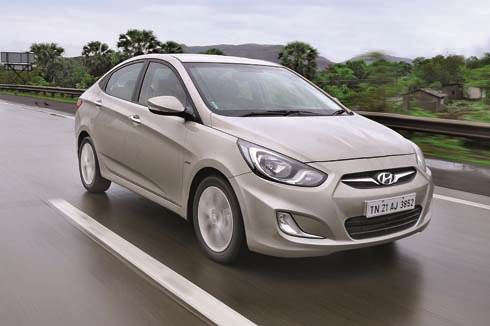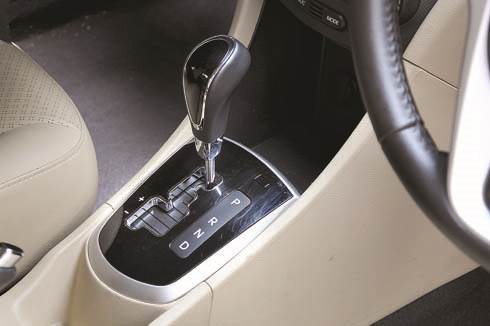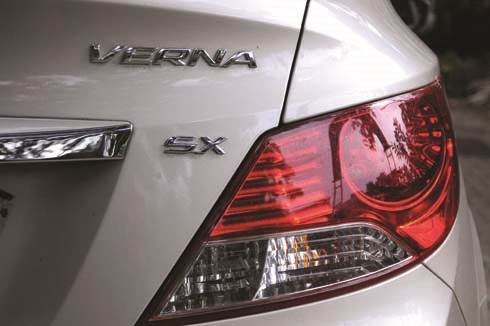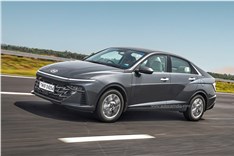2011 Hyundai Verna CRDi Auto
Is it better than the manual version?
Published on Jul 01, 2011 07:00:00 AM
1,13,693 Views
Follow us on


The all-new Hyundai Verna looks nothing like its predecessor and is the only diesel automatic saloon in its segment. It is set to take on its rivals, the Honda City and the Volkswagen Vento. It is also the cheapest diesel automatic on sale today, the next option being the Mahindra Scorpio which is an SUV. Priced at Rs 10.74 lakh (ex-showroom, Delhi), the automatic Verna costs Rs 70,000 over the manual version.
The transmission is the same old-school, four-speed automatic that did duty in the previous model, but the internals have been strengthened considerably to handle the extra twisting force. The Verna’s 1582cc common-rail turbo-diesel churns out 126bhp and 26.50kgm of torque efficiently to the power-sapping converter. Since it’s a four-speed, the gear ratios are tall and widely spaced, which is why the Verna doesn’t feel all that quick and accelerates in an extremely linear and relaxed manner. In traffic, it is extremely stress-free to drive thanks to the auto-box which eliminates some of the turbo-lag present in the manual version. The controls are light; it upshifts early, with fuel economy in mind, and the shifts are smooth and linear.
| Hyundai Verna Price, Mileage, Specifications, Features and Variants | |
|---|---|
| Brand | Hyundai |
| Model Name | Verna |
| Hyundai Verna Price | ₹ 12.86 - 20.27 lakh |
| Hyundai Verna Range/Mileage | Petrol : 18.6 - 20.6kpl |
| Hyundai Verna Specifications | Sedan | 5 doors | 5 seats View All Specs |
| Hyundai Verna Features | LED headlight | 10.25-inch Touchscreen display | 6 airbags View All Features |
| Hyundai Verna Variants | 1.5 Petrol EX MT | 1.5 Petrol S MT | 1.5 Petrol SX MT View All Variants |
On the highway, the Verna cruises nicely and isn’t very taxing to drive. There’s adequate power for overtaking, but the gearbox calls upon the engine’s torque reserves rather than kick-down. There is a fair bit of lag from the automatic-box, which means you will have to plan a bit before overtaking, especially on two-lane roads. The car is much quicker than it feels. It goes from 0-60kph in 5.20sec, which is only 0.7sec slower than the manual, and it touches 100kph in just 11.19sec, as compared to 10.54sec taken by the manual. The Verna is pretty good in terms of driveability. It takes 6.48sec to go from 20-80kph and 9.20sec for 40-100kph, which is actually much faster than its main rival, the petrol-powered Honda City auto. The manual variant and the automatic share the same soft suspension, which helps keep most minor irregularities out of the cabin at low speeds.
However, it feels a little unsettled thanks to the soft spring and hard damper settings on the car. At high speeds, the car bobs around on large dips and driving on an uneven road can be a little unsettling. The SX version comes equipped with ABS and four-wheel disc brakes. The pedal feels decent and the brakes bite well but they tend to fade after hard use. In terms of fuel efficiency, the Verna manages 11.5kpl and 15.3kpl in the city and highway respectively. In the city, the Verna’s mileage is 2kpl less than that of the manual; it does redeem itself on the highway though thanks to the tall fourth gear. The gearbox works well and though fuel efficiency is lower than that of the manual, it’s better than what you’d expect. It provides the economy of a diesel and the user-friendliness of an auto at an affordable price considering all the standard equipment on offer.
Tech Specs 
Copyright (c) Autocar India. All rights reserved.



.jpg&w=234&h=156&q=90&c=1)


 Price
Price Engine
Engine Transmission
Transmission Efficiency
Efficiency Body
Body Suspension
Suspension Steering
Steering Brakes
Brakes Dimensions
Dimensions
Comments
Member Login
Personal Details
No comments yet. Be the first to comment.